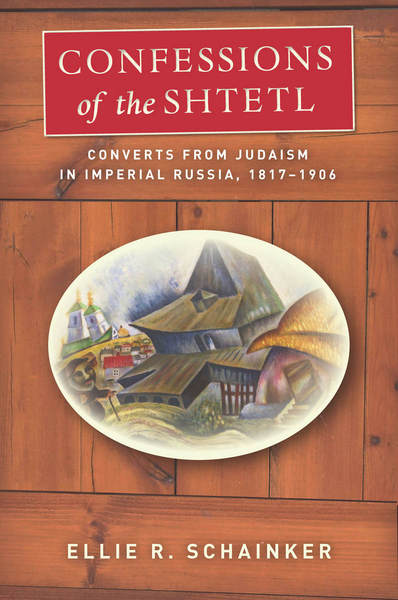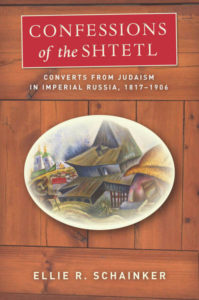
Confessions of the Shtetl. Converts from Judaism in Imperial Russia, 1817-1906 by Ellie R. Schainker
 The field of Jewish studies has developed considerably over the past few decades. In particular, the field, which has never closed off from other disciplines and area studies, has progressively opened up to insights and topics that are of interest to broader scholarly and social groups, from anthropologists, to historians, to social scientists of all stripes. For instance, the definition of “Jew” – the core object of this field, after all – has been examined, discussed, and expanded by scholars such as Benjamin Nathans, Yohanan Petrovsky-Shtern, Harriet Murav, and Gabriella Safran, to name just a few of the most outstanding practitioners working in the field of Jews in the Russian Empire. Ellie Schainker’s scintillating book on Jewish converts in Imperial Russia makes a significant contribution to this field, challenging us to examine our understanding of the term “Jewish” in this context.
The field of Jewish studies has developed considerably over the past few decades. In particular, the field, which has never closed off from other disciplines and area studies, has progressively opened up to insights and topics that are of interest to broader scholarly and social groups, from anthropologists, to historians, to social scientists of all stripes. For instance, the definition of “Jew” – the core object of this field, after all – has been examined, discussed, and expanded by scholars such as Benjamin Nathans, Yohanan Petrovsky-Shtern, Harriet Murav, and Gabriella Safran, to name just a few of the most outstanding practitioners working in the field of Jews in the Russian Empire. Ellie Schainker’s scintillating book on Jewish converts in Imperial Russia makes a significant contribution to this field, challenging us to examine our understanding of the term “Jewish” in this context.
To what extent are converts Jews at all? According to the Jewish, being Jewish is not a matter of “faith” but of birth (of a Jewish mother), y basta. However, even the state of Israel’s definition of “Jew” does not coincide with that of the halakhah. And, as Schainker makes clear, this ambiguity was very evident quite early (even before the Great Reforms of the 1860s-1870s) in Imperial Russia.
The Russian Empire was, as Paul Wirth, Robert Crews, and many others have pointed out, a “confessional state.” Christianity in its Orthodox version (pravoslavie) was the privileged – “reigning” – religion. While Tsar and his family had to belong to that religion (though of course no tsarina in this period was born into Orthodoxy; all converted before marriage), other confessions were tolerated to a greater or lesser extent. Jews were subject to severe disabilities, not allowed to reside – with some exceptions – outside the notorious Pale of Settlement (roughly, the lands taken by Russia from Poland in the late eighteenth century), barred from certain professions, and toward the end of the nineteenth century subjected to restrictions on entry into educational establishments. Thus, traditionally, conversion has been seen as primarily a method of social advancement, of throwing off the legal and social restrictions involved in being a Jew. As Hans Rogger pointed out several decades ago, by the early twentieth century, the Russian government had come to regard converts with great suspicion. Some officials even advocated making a legal distinction between them and Christians born into the faith.
Schainker’s interest and approach is rather different. She bookends her monograph with two fairly obscure dates. She begins in 1817, when Tsar Alexander I “established the Society of Israelite Christians” as well as creating the “Dual Ministry” (of Spiritual Affairs and Popular Enlightenment) which, in Schainker’s words, “housed all religious confessions under one ministry, ostensibly denying Russian Orthodoxy primacy over other imperial faiths” (29). Schainker’s end date is a bit more familiar: as one of the outcomes of the 1905 revolution, in 1906 the boundaries of religious freedom in the Russian Empire expanded considerably when it became legally possible to convert out of Orthodoxy and – in principle, anyway – from a Christian to a non-Christian religion. Both of these dates mark very significant steps toward a more tolerant legal treatment of religion within the empire, but in this book Schainker is less interested in narrow legality than in the complications that arose when apparently clear principles were applied to the “crooked timber of humanity.”
Schainker divides her book into three sections, focusing on the state, the shtetl, and finally converts “on the move”, in particular in southern “Russia” (often present-day Ukraine is meant). The book concludes with an interesting chapter looking at “converts on the [mainly Russian] cultural map” in this period and much later. The author’s point that very converts frequently remained close to the Jewish community is very well taken, as the names Daniel Chwolson (in the Russian context) and Jan Bloch (in the Polish) attest. The old-fashioned image of the convert utterly rejected by and cut off from the Jewish community clearly needs serious revision.
While Schainker’s overall thesis about the importance of conversion both for the Jewish community and official Russia is convincing, probably the greatest contribution of this book is in its specific case studies and anecdotes about Jews, Jewish converts, and the ambiguity they created. In her chapter on the “missionizing marketplace,” describing efforts – often by Jewish converts – to familiarize Jews with Christian beliefs and culture (including the New Testament), Schainker describes one “entrepreneurial convert,” Alexander Alekseev waxing nostalgic about the charms of the Jewish Sabbath while working to bring the “new covenant” to Russia’s Jews. The Orthodox clergy was, on the whole, less than enthusiastic about conversions. Much more active in encouraging conversions were both the Catholic clergy and – remarkably – the London Society for Promoting Christianity among the Jews, which published both Hebrew and Yiddish translations of the New Testament. Another source of converts in the first half of the nineteenth century was the Russian army though, as Yohanan Petrovsky-Shtern has pointed out, the “cantonists” (young forced recruits in the Russian army) were not always the passive victims of Christian fanaticism. Still, many cantonists did convert and a few, like Alexander Alekseev, became true “Jews for Jesus” in pushing their new faith. But even the pious Christian Alekseev, as Schainker points out, did not reject all aspects of his Jewish background and even collected and published works (in Russian) on Jewish beliefs, culture, and rituals. These works, unlike those of another far better known, even infamous convert, Yakov Brafman (also discussed here), did not dismiss Jewish culture as inherently anti-Christian and subversive.
The figure of the Jewish tavern keeper is something of a stock image in Russian and Polish Jewish culture. While the entire village (at least, its male component) frequented the tavern, one does not often consider the tavern as a site of Christian-Jewish interplay and its inevitable consequence, conversion. And yet, as Schainker makes clear, it was precisely at taverns that young women (often the Jewish tavern keeper’s daughter) met and fell in love with Christian men. In several cases, the girl’s relatives attempted to prevent the conversion and marriage by abducting (or such was the accusation) the would-be bride, and thus these cases were preserved in the archives for future historians.
To be sure, the path from Judaism to Christianity was always complicated (parents generally objected strenuously, especially when the would-be convert was still in his or her teens) and sometimes accompanied by violence. Schainker devotes a chapter to the issue of Jewish violence against would-be converts, weaving together accounts in the Russian press, literature, and visual arts with documented cases from the archives. And, of course, where there are marriages there will be divorces, officially or informally. Marriage is a particularly interesting field of research for both legal and social history since the Russian Empire generally allowed religious communities to deal according to their own rules with marriage and “family law” (e.g., Muslim men could have more than one wife, but Christians could not). This intersection of legal systems caused particular distress when, for example, a Jewish husband converted to Christianity without first issuing a “get” (divorce document) to his (Jewish) wife. Without this document, she could not re-marry and the wife found herself in an unenviable position within the community. And what was to be done, for example, with Peshi Tiskevicha, born to a Jewish woman but whose (absconded) father had been a convert? Typically for the Russian Empire, a verdict was reached (to take the child away from her Jewish mother, since the child’s religion legally followed that of the father), but then the decision was not carried out as the authorities were unable to locate child and mother.
Further complicating this fascinating picture, Schainker ends her book with a discussion of little-known “Jewish Christian sects.” As we have seen, the imperial government tolerated and even encouraged Jews to convert to non-Orthodox denominations of Christianity, such as the Anglican church. A few converts took matters a step further, however, by setting up their own particular groups that merged certain Jewish ritual practices with Christian beliefs and Bible study. In an empire where Christian “Old Believers” were persecuted until the early twentieth century, such religious mixtures could only be regarded with misgivings by local officials. And yet, as Schainker shows, while the sects were indeed denounced to the authorities (her main sources are precisely these denunciations and subsequent investigations and/or trials), the imperial authorities were not quick to shut them down. Instead, some officials even argued that the sects, while unorthodox (in all senses of the word), could also provide a kind of bridge between Judaism and the Christian faith. Furthermore, the example of these sects provided grist for the mill of Jewish reformers who argued (taking a page from the earlier German Jewish Reform movement) that Jewish ritual practice needed modernizing. Thus these “hybrid Jewish-Christian groups” (225) revealed both Russian officialdom’s concept (or hope) of how Jews could be gradually inched toward Christianity and Jewish reformers’ plans to make ritual practice more consonant with the demands of the modern world.
That tens of thousands of Jews in the Russian Empire converted to Christianity in the nineteenth century is not news. What makes this book so novel and stimulating is its investigation into the very concept of “Jew” vs. “Christian” and showing how the blurring of confessional lines caused by conversion forced official and everyday individuals to react, sometimes in surprising ways. For anyone interested in European history, the intricacies of religious and inter-ethnic toleration, and of course Jewish studies, this book is highly recommended.
Reviewed by Theodore R. Weeks, Southern Illinois University, Carbondale
Confessions of the Shtetl. Converts from Judaism in Imperial Russia, 1817-1906
by Ellie R. Schainker
Publisher: Stanford: Stanford University Press
Hardcover / 339 pages / 2017
ISBN: 9780804798280
Published on July 31, 2017.




